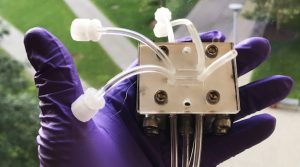Global S&T Development Trend Analysis Platform of Resources and Environment
| Scientists develop system to remove contaminants from nuclear wastewater | |
| admin | |
| 2019-12-31 | |
| 发布年 | 2019 |
| 语种 | 英语 |
| 国家 | 国际 |
| 领域 | 地球科学 |
| 正文(英文) |  Nuclear power plant cooling tower in Doel, Belgium. (Reference image by Trougnouf, Wikimedia Commons)
Researchers at the Massachusetts Institute of Technology have developed a method to reduce the volume of contaminated water that needs to be disposed of in nuclear plants. In a paper published in the journal Environmental Science and Technology, the scientists said that the mechanism concentrates the radioactive isotopes that contaminate the water used for cooling the plants and allows for the rest of the water to be recycled through the plant’s cooling system. The method makes use of a process called shock electrodialysis, which uses an electric field to generate a deionization shockwave in the water. The shockwave pushes the electrically charged particles, or ions, to one side of a tube filled with charged porous material, so that concentrated stream of contaminants can be separated out from the rest of the water.  During the course of their experiments, the group discovered that two radionuclide contaminants—isotopes of cobalt and caesium— can be selectively removed from water that also contains boric acid and lithium. After the water stream is cleansed of its cobalt and caesium contaminants, it can be reused in the reactor. To test of the system, the researchers used simulated nuclear wastewater based on a recipe provided by Mitsubishi Heavy Industries, which sponsored the research. In the trials, after a three-stage separation process, they were able to remove 99.5% of the cobalt radionuclides in the water while retaining about 43% of the water in cleaned-up form so that it could be reused. As much as two-thirds of the water can be reused if the cleanup level is cut back to 98.3% of the contaminants removed. “No other practical, continuous, economic method has been found for separating out the radioactive isotopes of cobalt and caesium, the two major contaminants of nuclear wastewater,” said Martin Bazant, senior author of the study, in a media statement. “Not only is the new system inexpensive and scalable to large sizes but, in principle, it also can deal with a wide range of contaminants. It’s a single device that can perform a whole range of separations for any specific application.” According to Bazant and lead author Mohammad Alkhadra, while the method could be used for routine cleanup, it could also make a big difference in dealing with more extreme cases, such as the millions of gallons of contaminated water at the Fukushima Daichi power plant in Japan, where the accumulation of that contaminated water has threatened to overpower the containment systems designed to prevent it from leaking into the Pacific ocean.
|
| URL | 查看原文 |
| 来源平台 | Minging.com |
| 文献类型 | 新闻 |
| 条目标识符 | http://119.78.100.173/C666/handle/2XK7JSWQ/219323 |
| 专题 | 地球科学 |
| 推荐引用方式 GB/T 7714 | admin. Scientists develop system to remove contaminants from nuclear wastewater. 2019. |
| 条目包含的文件 | 条目无相关文件。 | |||||
| 个性服务 |
| 推荐该条目 |
| 保存到收藏夹 |
| 查看访问统计 |
| 导出为Endnote文件 |
| 谷歌学术 |
| 谷歌学术中相似的文章 |
| [admin]的文章 |
| 百度学术 |
| 百度学术中相似的文章 |
| [admin]的文章 |
| 必应学术 |
| 必应学术中相似的文章 |
| [admin]的文章 |
| 相关权益政策 |
| 暂无数据 |
| 收藏/分享 |
除非特别说明,本系统中所有内容都受版权保护,并保留所有权利。
修改评论